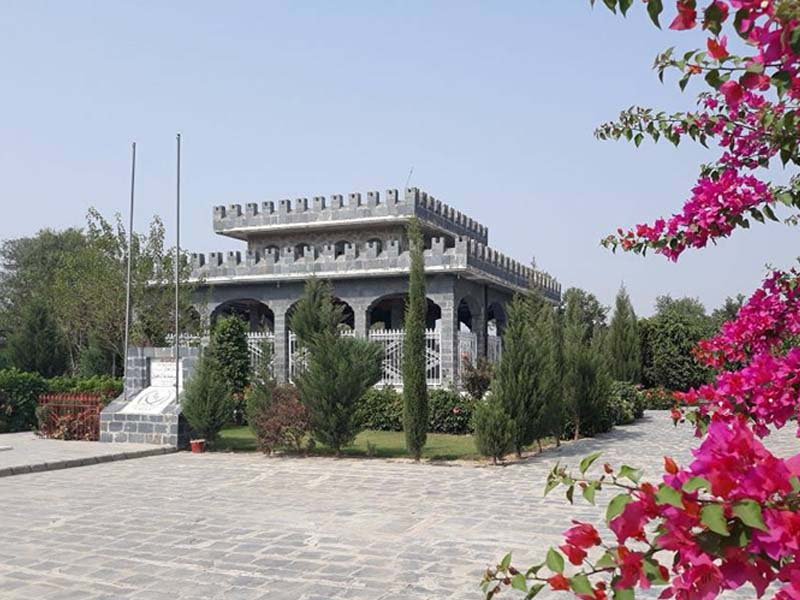
For several centuries, his final resting place remained in a state of oblivion and its was found on word of mouth and for the construction of tomb with the financial support of late nationalist politician Azam Khan Hoti during the previous government of Awami National Party.
At the entrance of the tomb is a beautiful Pashto ‘Tapa’ etched on a marble slab says ‘When Kajju Khan was the ruler, illuminated were the Hujras of Pakhtuns’. Tapa, an important part of Pashto folklore and a source of past history, tells about the times, when Malik Gajju Khan led the Pakhtuns and maintained a sovereign state and defeated the mighty Mughal forces at Peshawar.
“We’ve been kept deprived from our own history,” said Saeedullah 70, who visited the site along with his family members. “This is also the reason that for most Pakhtuns the tomb of Gajju Khan is a mystery.” In the past, shrubs had covered the grave, said Saeed, we are happy that someone has paid attention and constructed a tomb for our past heroes.
“This will be helpful in creating a sense of identity among the youth and they would be also educated about their glorious past,” hoped Saeedullah.
Egypt unveils tomb of ancient priestess
Malik Gajju Khan also as Kajju Khan was the Chief of Yousafzai, the largest of the Pakhtun clans. The Yousafzai also considered themselves as the descendents of Gajju Khan Baba.
The details available for public at the shrine say that Kajju Khan was born in Kabul in 1490 at the time, when the Mughal governor Mirza Alagh Baig started persecution of Pakhtuns in Kabul and killed a number of Yousafzai elders, Gajju Khan in a cradle at the time shifted to Dohaba along with Yousafzai tribe under the leadership of Malik Ahmad Baba.
Malik Baba who had reorganised the Yousafzai tribe established a Pukhtun’s state with Malakand as its capital. But after his death, probably in 1535, there was a need of a leader among them as his sons were at each other’s throats for the throne and not in position to lead. Professor Robert Nichols in his book ‘Settling the Frontier: Land, Law, and society in Peshawar,’ writes that sibling jealousy between Ahmad’s most notable sons, Al-hoda and Ismael, led to factionalism within the clan. For this purpose a Jirga of Sardars was held after deliberation, they agreed on Kajju to lead the Yousafzai tribe as he was not only a superior soldier but had also a large number of kinsmen.
Under Ahmad’s leadership, Malik Kajju had already displayed great heroism in war of Swat which was fought in 1515. He has also led army in the historical war of Katlang fought in 1520 and helped forming a great confederation of tribes.
In his leadership, Malik Kajju expanded the Pakhtun state from Jehlum to Kandahar. The numbers in his army swelled to 0.2 million and till 1540, a vast area came under his control. In 1551, the war of Mangrao was fought and Kaju Khan with the help of some sixty thousand soldiers defeated the ruler of Mangrao, Ghayasuddin and brought it under Pakhtunkhwa.
In 1553, Mughal Emperor Humayun attacked Peshawar from Kabul, it was Khan Gajju Khan who with the support of 150,000 men defeated the Mughal’s General Sikandar Uzbek who was forces to take shelter in Balahisar fort.Emperor Humayun instead of proceeding towards Peshawar had to return to Kabul. While his general, Uzbek was sent safely after he paid war reparations and apologised for the attack on Peshawar.
The government of Khyber-Pakhtunkhwa has set up a medical college in his name of Pashtun legend. “Now that the mausoleum has been constructed as well a medical college in the district,” said Saeedullah “People will be able to have knowledge about their past and their heroes.” He added there is also need to teach the students about Pakhtuns history, so that they have some awareness about their actual history.
Published in The Express Tribune, February 25th, 2018.











COMMENTS
Comments are moderated and generally will be posted if they are on-topic and not abusive.
For more information, please see our Comments FAQ